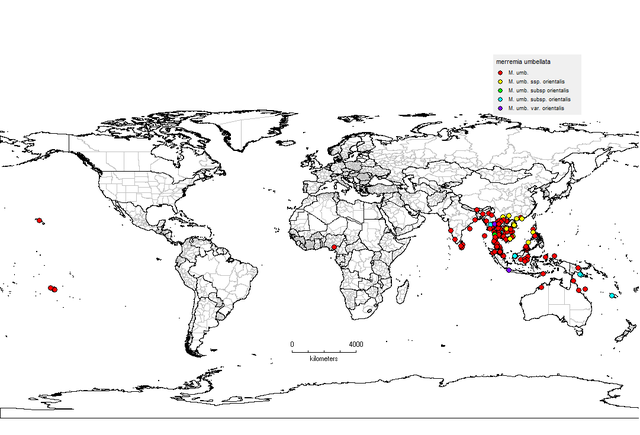Nomenclature
Merremia umbellata (L.) Hallier f., Bot. Jahrb. Syst. 16: 552. 1893.
Convolvulus umbellatus L., Sp. Pl. 1: 155. 1753
Convolvulus cymosus Desr. in Lam., Enc. 3: 556. 1791.
Ipomoea cymosa (Desr.) Roem. & Schultes, Syst. Veg. 4: 241. 1819
Ipomoea umbellata (L.) G.F.W. Meyer, Prim. Fl. Esseq. 99. 1818, nomen illegit. non L. (1759).
Merremia umbellata (L.) Hallier f. var. umbellata Bull. Soc. Bot. Belg. 35: 270. 1896.
Merremia umbellata var. occidentalis Hallier f., ‘s Versl. plant. Buit. 127. 1896. an illegitimate substitute name for the tautonymic variety.
Convolvulus multiflorus Miller, Gard. Dict. ed. 8. n. 15. 1768. TYPE. based on Plukenet, Phyt. plate 167. fig. 1. (no specimen found; the plate could be taken as lectotype).
Convolvulus aristolochiofolius Miller, Gard. Dict. ed. 8. n. 9. 1768. TYPE. plants cultivated in England, from seed gathered in Cartagenua, New Spain (type K?).
Ipomoea polyanthes Roem. & Schultes, Syst. Veg. 4: 234. 1819. TYPE. a new name for C. umbellatus L. (1753).
Convolvulus sagittifer Kunth in Humboldt, Bonpland and Kunth, Nov. Gen. Sp. Pl. 3: 100. 1819. TYPE. Cuba, prope Havana, Humboldt & Bonpland 1303 (isotype P).
Ipomoea sagittifer (Kunth) G. Don, Gen. Syst. 4: 273. 1838.
Convolvulus caracassanus Roem. & Schultes, Syst. Veg. 4: 301. 1819. TYPE. Venezuela. Caracas, Humboldt & Bonpland (B-W 3658).
Convolvulus luteus Martens & Galleotti, Bull. Acad. Roy. Brux. 12: 260. 1845. TYPE. Mexico. dans les dunes de Vera-Cruz, Galleotti 1379 (holotype BR).
Convolvulus micans Garcke, Linnaea 22: 66. 1849. TYPE. Surinam. in sepibus prope Paramaribo, Dec. 1844, herb. Kegel. 683 (not found).
Ipomoea mollicoma Miquel, Stirp. Surin. Sel. 132. tab. 37. 1830. TYPE. Surinam. locis cultis prope Bergendaal, Focke 1149 (isotype U).
Ipomoea primulaeflora G. Don, Gen. Syst. 4: 270. 1838. TYPE. Africa. Sierra Leone: G. Don (holotype BM).
Convolvulus densiflorus Hooker, Bot. Beechey’s Voy. 303. 1841. TYPE. Mexico. Arnott (holotype K).
Ipomoea multiflora (Miller). Roem. & Schultes, Syst. Veg. 4: 234. 1819.
Merremia rondoniana Hoehne, Anex. Mem. Inst. Butantan 1: 60. plate 13. 1922. TYPE. Brazil. Mato Grosso: Corumba, Hoehne 3041 (holotype R).
Description
Fang R.C., G. Staples, et al. 1995. Convolvulaceae in P. Raven & C.Y. Wu (eds.) Flora of China 16: 271–325.
Austin, D. F. & G. W. Staples. Convolvulaceae in Flora Neotropica [unpublished data].
Cytology
Fang R.C., G. Staples, et al. 1995. Convolvulaceae in P. Raven & C.Y. Wu (eds.) Flora of China 16: 271–325.
Biogeography, Ecology and Natural History


Africa, Asia, Australia (Northern Territory, Queensland), North America, Pacific Islands, South America, China (Guangdong, Guangxi, Hainan, Taiwan, Yunnan), ?Bangladesh, Cambodia, Indonesia, Laos, Malaysia, Myanmar, Nepal, New Guinea, Philippines, Sri Lanka, Thailand, Vietnam.
U.S.A., West Indies, Mexico, Middle America and South America.
Roadsides, forested
valleys, thickets; 0–1600 m.
Thailand: Clearings, deforested
areas, and vacant land in villages, mixed deciduous forest, evergreen hill
forest, swamp margins, secondary scrub; altitude: 25–1200 m.
Flowering: January—March, October—December; fruiting: January, February, October, December.
Fang R.C., G. Staples, et al. 1995. Convolvulaceae in P. Raven & C.Y. Wu (eds.) Flora of China 16: 271–325.
Austin, D. F. & G. W. Staples. Convolvulaceae in Flora Neotropica [unpublished data].
Johnson, R. W. Austrobaileya 8: 55–63. 2009
Other information
Van Ooststroom (Blumea 3: 341–342. 1939) compared and contrasted the two varieties (later elevated to subspecies) of Merremia umbellata. Subspecies umbellata is distributed throughout the American tropics (Mexico, Central America, the West Indies, and South America as far south as Paraguay) and in western tropical Africa is a more robust plant, typically with more and larger flowers per inflorescence, corollas always yellow, capsules subglobose, with broader ovate valves, and seeds pubescent to shortly tomentose, the hairs only slightly longer on the margins. Asian plants have been considered a single, polymorphic and highly variable subspecies, Merremia umbellata subsp. orientalis (Hallier f.) Ooststr., Fl. Malesiana, ser. 1, 4(4): 449. 1953.
Merremia umbellata is one of a number of species in sect. Xanthips in Asia. While M. umbellata is clearly recognizable in North and South America, as well as tropical Africa, but the situation is not so clear on the continental mainland of Asia and in Malesia. We point out that M. umbellata subsp. orientalis encompasses a much greater variation in plant size, number of flowers per inflorescence, flower color, and density and distribution of indumentum. Further study of the tropical Asian species of sect. Xanthips is needed before a clearer concept of M. umbellata, its infraspecific taxa, and related species can be reached.
Van Ooststroom (Fl. Males. ser. I, 4: 449. 1953) recognized Asian and Malesian plants of M. umbellata as subsp. orientalis (Hallier f.) Ooststr., a taxonomic concept I have long agreed with. However, after seeing the considerable variability in continental Asian specimens, particularly those from Thailand and Indochina, I hesitate to include all this variability within subsp. orientalis. Until a more detailed study of the variability can be made, and appropriate infraspecific taxa recognized, I am simply calling all Thai and SE Asian specimens M. umbellata. This is an extraordinarily polymorphic species, in the past much confused with M. kingii and M. bambusetorum, though now that adequate material is at hand the differences between these three species are somewhat clearer. Merremia umbellata can be recognized by its whitish puberulent axial parts, especially the pedicels; the crowded, umbelliform inflorescences (the secondary and tertiary branches short or none); the unequal sepals, with the outer two shorter, obovate, tapering to narrow bases between which the inner sepals are visible. Generally, the flowers of M. umbellata are smaller and there are more of them per inflorescence than in M. bambusetorum and M. kingii, though precise delimitation for these 3 species remains elusive.
Authorship for webpage



Add new comment